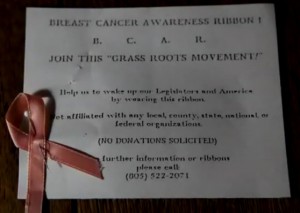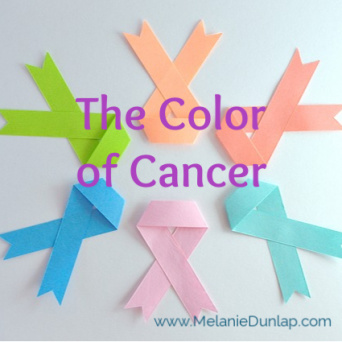A pink ribbon has become the universal sign of breast cancer support. They are called awareness ribbons; symbols meant to show support or raise consciousness for a cause.
But the pink ribbon didn’t start out that way.
Pop culture was influential in creating our ribbon awareness. In 1973, Tony Orlando and Dawn released a record called “Tie a Yellow Ribbon Round the Old Oak Tree,” which sold 3 million records in the first three weeks of its release. During the 1979 hostage crisis at the U.S. embassy in Tehran, a wife of one of the hostages tied a yellow ribbon around a tree in her yard and suggested to the Washington Post that others do the same. By the time the hostages were released the country was covered in yellow ribbons, including the White House.
Yellow ribbons were again popular during the 1985 TWA hostage crisis and the First Gulf War in 1990 and 1991. The yellow ribbon campaigns inspired AIDS activists to create a red ribbon to raise awareness. In what was seen then as a bold move, Jeremy Irons worn a red ribbon when he hosted the 1991 Tony Awards.
The awareness ribbon quickly became so popular that The New York Times declared 1992 “The Year of the Ribbon.”
Breast Cancer Ribbons

Charlotte Haley’s Breast Cancer Awareness Ribbons ~ Photo courtesy of Breast Cancer Action
What has become the most famous ribbon of them all, the breast cancer ribbon, was originally peach colored. In 1991 a California woman named Charlotte Haley, then 68, came up with the idea to make peach colored ribbons to bring attention to breast cancer. Several of her family members had been touched by the disease and Charlotte believed strongly that cancer prevention was not being funded adequately.
Charlotte attached 5 peach colored ribbons to a card that read “The National Cancer Institute’s annual budget is $1.8 billion, and only 5 percent goes to cancer prevention. Help us wake up our legislators and America by wearing this ribbon.” In her grassroots effort, she handed out thousands of ribbons at local supermarkets and wrote letters to prominent women around the country. She never took money for the ribbons.
In 1992 her peach ribbons caught the attention of Alexandra Penney, editor in chief of Self magazine, and Evelyn Lauder, VP of Estee Lauder. They approached Charlotte about a partnership between them and her peach ribbon campaign. She refused the offer saying that their planned use was too commercial.
Self magazine was already committed to their second annual Breast Cancer Awareness month issue and Evenly had promised to put ribbons on the cosmetic counters of Estee Lauder stores. They really wanted a ribbon, but they couldn’t use Charlotte’s idea, so they did what the lawyers suggested, they came up with another color.
They chose pink.
In fall 1992, a pink ribbon was featured on the cover of Self magazine and Estee Lauder cosmetic counters gave away 1.5 million pink ribbons with a laminated card describing how to do a breast self-exam. In addition to the giveaways they also gathered 200,000 pink ribbon petitions urging for increased government funding for research.
Within a year, Charlotte’s peach ribbon was history.
Pink was already being used in connection with breast cancer by the Susan G. Komen for the Cure organization. They used the color to raise money and in 1991 they gave pink ribbons to participants in the New York City race. The next few years would see a boom in the number of big corporations that attached themselves to the pink ribbon.
Other Colors
Pink may be the most well-known color, but there is a kaleidoscope of colors representing different types of cancers. There are solid colors like pink for breast and yellow for bone. There are color combinations like white & teal for cervical cancer or thyroid cancer’s blue, pink & teal. The lesser well-known carcinoid cancer uses a Zebra print to stand out from the crowd.
There is no official cancer color registry. Colors are not assigned but are rather chosen by the organization representing that cancer. Color representation can change too. Colorectal cancer was once represented by brown ribbons then switched to dark blue. Brown was an understandable choice, but it didn’t make people feel good.
The color of cancer really blossomed in 1999 when a for-profit company called Choose Hope began selling merchandise for cancer patients and survivors. According to Linda Nielsen, one of Choose Hope’s founders, there were only six cancer awareness colors when they started and today there are 29 colors.
Cancer awareness has become big business.
What’s my color?
Here is a list of the most common cancers and their awareness colors:
| Appendix Cancer | Amber |
| Bladder Cancer | Blue, Yellow & Purple |
| Bone Cancer | Yellow |
| Brain Cancer | Grey |
| Breast Cancer | Pink |
| Carcinoid Cancer | Zebra Print |
| Cervical Cancer | White & Teal |
| Childhood Cancer | Gold |
| Colon Cancer | Dark Blue |
| Esophageal Cancer | Periwinkle |
| Gallbladder Cancer | Kelly Green |
| Head & Neck Cancer | White & Burgundy |
| Hodgkin Lymphoma | Violet |
| Kidney Cancer | Orange |
| Leukemia | Orange |
| Liver Cancer | Emerald Green |
| Lung Cancer | White or Pearl |
| Multiple Myeloma | Burgundy |
| Non-Hodgkin Lymphoma | Lime Green |
| Ovarian Cancer | Teal |
| Pancreatic Cancer | Purple |
| Prostate Cancer | Light Blue |
| Skin Cancer | Black |
| Stomach Cancer | Periwinkle Blue |
| Testicular Cancer | Light Purple |
| Thyroid Cancer | Blue, Pink & Teal |
| Uterine or Endometrial Cancer | Peach |
If this seems a little overwhelming don’t worry there is one color that covers all cancers…Lavender!
.
Choosing to wear a specific color or ribbon can be a show of support for someone you know who has been touched by cancer. That someone may even be you.
